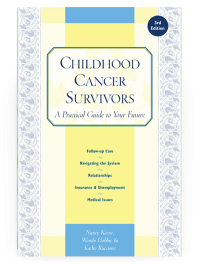Childhood Cancer Survivors
Non-Hodgkin lymphoma
Non-Hodgkin lymphoma (NHL) is the third most common childhood cancer (after leukemia and brain tumors). Approximately 800 children younger than age 20 are diagnosed with NHL in the United States every year. It is rare in very young children, and the incidence increases with age. There is an increased risk of NHL in children diagnosed with AIDS. Childhood NHL is more common in males than in females, and slightly more white children than black children are diagnosed with NHL. The 5-year survival rate for children younger than age 15 is 88 percent, and for 15 to 19 year olds is 77 percent.
Description
Lymphomas are cancers of the lymph system. This system is made up of lymph vessels throughout the body that carry a colorless liquid called lymph. Throughout this network, groups of small organs called lymph nodes make and store lymphocytes—cells that fight infection. Lymph tissue is found throughout the body, so NHL can be found in almost any organ or tissue, such as the liver, bone marrow, or spleen. Hodgkin and NHL are differentiated by cell type and require different treatments.
Although there are many different types of NHL, the three most common in children are lymphoblastic, small noncleaved cell lymphoma (Burkitt’s and non-Burkitt’s), and large cell lymphoma.
Treatment
Treatment for NHL is based on histology (meaning how the tissue and cells look under a microscope) and clinical stage. Several staging systems are used.
Radiation
In the past, radiation was given to most children with NHL, and its use significantly increased the toxicity of treatment. Currently, radiation is used only for tumors in the chest that cause trouble breathing, compression of major blood vessels, testicular tumors, or primary NHL of bone. The use of radiation in even these situations is in dispute in scientific circles. Many experts now believe radiation should be used only in exceptional circumstances for children or teens with NHL.
Chemotherapy
The mainstay of treatment for NHL is combination chemotherapy. Drugs used to treat this disease include vincristine (Oncovin ® ), doxorubicin (Adriamycin ® ), cyclophosphamide (Cytoxan ® ), prednisone, mercaptopurine (6-MP or Purinethol ® ), methotrexate, daunorubicin (Cerubidine ® ), cytarabine (ARA-C), thioguanine (6-TG), and asparaginase.
Almost all children and teens with NHL stage III and stage IV receive intrathecal methotrexate regardless of the tumor location to prevent the spread of the tumor into the cerebrospinal fluid and brain.
Late effects
This section briefly outlines some common and uncommon late effects from treatment. Remember that you may develop none, one, or several of these problems in the months or years after treatment ends.
Children with stage I or II NHL may have few or no long-term effects. Children with stage III or IV NHL, or those who have relapsed and require more intensive treatment, sometimes pay a higher price.
Fertility. Female fertility usually is not affected by treatment for lymphoma unless the girl had spinal radiation that included the ovaries or had very high doses of cyclophosphamide—more than 7.5 grams per square meter (grams/m 2 ). In the majority of cases, girls treated for lymphoma have normal growth, sexual development, and fertility. The chances of having a normal pregnancy and birth if fertility is not affected are the same as for the general population.
The use of methotrexate, vincristine, cyclophosphamide, and prednisone cause a rapid decrease in sperm count in male teens who have passed puberty. Normal sperm production and motility generally return after treatment. Boys treated for lymphoma before puberty usually experience a normal puberty. However, patients who received very high doses of cyclophosphamide (more than 7.5 grams/m 2 ) or radiation to the testes should have testosterone levels and sperm count checked. Most males treated with chemotherapy alone have normal growth, sexual development, and fertility. For more information about growth and fertility, see Chapter 9 .
Heart problems. In a small number of survivors, heart problems can occur months or years after treatment with anthracyclines (i.e., doxorubicin, idarubicin, or daunorubicin), high-dose cyclophosphamide, or chest radiation. Symptoms include shortness of breath, fatigue, wheezing, anxiety, poor exercise tolerance, rapid heartbeat, and irregular heartbeat. Survivors often have no symptoms, but problems may be found on cardiac tests such as echocardiograms, electrocardiograms (EKGs), and Holter monitors. For more information, see Chapter 12 .
Hepatitis C. Infection with the hepatitis C virus can develop in survivors who had blood transfusions prior to July 1992. For more information, see Chapter 15 .
Learning disabilities. Cranial radiation, intrathecal methotrexate, and/or high-dose methotrexate may cause cognitive problems. Learning disabilities can develop years after treatment ends. Typically, problems develop in the areas of mathematics, spatial relationships, problem solving, organization, planning, attention span, concentration skills, and social skills. For more information, see Chapter 8 .
Dental problems. Dental abnormalities can occur after chemotherapy or radiation to the jaw area. The most frequent problems are failure of the teeth to develop, arrested root development, unusually small teeth, and enamel abnormalities. For more information, see Chapter 11 .
Uncommon late effects. Extremely rare late effects include bladder problems (i.e., hemorrhagic cystitis and bladder fibrosis) from cyclophosphamide, osteonecrosis (death of blood vessels that nourish bones) from high-dose steroids, and second cancers.
Table of Contents
All Guides- 1. Survivorship
- 2. Emotions
- 3. Relationships
- 4. Navigating the System
- 5. Staying Healthy
- 6. Diseases
- 7. Fatigue
- 8. Brain and Nerves
- 9. Hormone-Producing Glands
- 10. Eyes and Ears
- 11. Head and Neck
- 12. Heart and Blood Vessels
- 13. Lungs
- 14. Kidneys, Bladder, and Genitals
- 15. Liver, Stomach, and Intestines
- 16. Immune System
- 17. Muscles and Bones
- 18. Skin, Breasts, and Hair
- 19. Second Cancers
- 20. Homage
- Appendix A. Survivor Sketches
- Appendix B. Resources
- Appendix C. References
- Appendix D. About the Authors
- Appendix E. Childhood Cancer Guides (TM)

